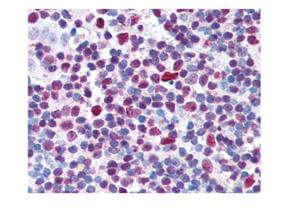Anti-CREB pS133 (RABBIT) Antibody
CREB phospho S133 Antibody
- SPECIFICATION
- CITATIONS
- PROTOCOLS
- BACKGROUND

| Host | Rabbit |
|---|---|
| Conjugate | Unconjugated |
| Target Species | Human |
| Reactivity | Rat, Human, Mouse |
| Clonality | Polyclonal |
Application
| WB, IHC, E, I, LCI |
| Application Note | Anti-CREB pS133 antibody reacts with phosphorylated human CREB at pS133 and shows minimal reactivity by western blot with non-phosphorylated CREB and minimal reactivity (1%) by ELISA against the non-phosphorylated form of the immunizing peptide. This antibody was assayed against a variety of tissues including fibroblasts and B-cell lysates. Bands of 46 and 43 kDa corresponding to phosphorylated CREB are observed in western blots. Anti-CREB pS133 is suitable for the detection by immunoblot of phosphorylated human, mouse and rat CREB. No cross-reactivity occurs with non-phosphorylated CREB. For immunohistochemistry, formalin fixed, paraffin embedded human tissue shows moderate to strong nuclear staining in a variety of cells with minimal background staining. Although not tested this antibody is likely functional by FACS and immunoprecipitation. |
| Physical State | Liquid (sterile filtered) |
| Buffer | 0.02 M Potassium Phosphate, 0.15 M Sodium Chloride, pH 7.2 |
| Immunogen | CREB phospho peptide corresponding to amino acid residues 122-147 of the human protein conjugated to Keyhole Limpet Hemocyanin (KLH). |
| Preservative | 0.01% (w/v) Sodium Azide |
| Gene ID | 1385 |
|---|---|
| Other Names | 1385 |
| Purity | Anti-CREB pS133 was affinity purified from monospecific antiserum by immunoaffinity purification. Antiserum was first sequentially pre-adsorbed against a control E.coli lysate, nickel-purified recombinant CREB and the non-phosphorylated form of the immunizing peptide. The resultant depleted antiserum was then purified against the phosphorylated form of the immunizing peptide. This phospho specific polyclonal antibody is specific for phosphorylated pS133 of human CREB. Reactivity with non-phosphorylated CREB is minimal. This antibody does show cross reactivity with pS133 phosphorylated CREB from mouse and rat. |
| Storage Condition | Store vial at -20° C prior to opening. Aliquot contents and freeze at -20° C or below for extended storage. Avoid cycles of freezing and thawing. Centrifuge product if not completely clear after standing at room temperature. This product is stable for several weeks at 4° C as an undiluted liquid. Dilute only prior to immediate use. |
| Precautions Note | This product is for research use only and is not intended for therapeutic or diagnostic applications. |
| Name | CREB1 |
|---|---|
| Function | Phosphorylation-dependent transcription factor that stimulates transcription upon binding to the DNA cAMP response element (CRE), a sequence present in many viral and cellular promoters (By similarity). Transcription activation is enhanced by the TORC coactivators which act independently of Ser-119 phosphorylation (PubMed:14536081). Involved in different cellular processes including the synchronization of circadian rhythmicity and the differentiation of adipose cells (By similarity). Regulates the expression of apoptotic and inflammatory response factors in cardiomyocytes in response to ERFE-mediated activation of AKT signaling (By similarity). |
| Cellular Location | Nucleus {ECO:0000255|PROSITE-ProRule:PRU00312, ECO:0000255|PROSITE-ProRule:PRU00978, ECO:0000269|PubMed:12552083} |

Thousands of laboratories across the world have published research that depended on the performance of antibodies from Abcepta to advance their research. Check out links to articles that cite our products in major peer-reviewed journals, organized by research category.
info@abcepta.com, and receive a free "I Love Antibodies" mug.
Provided below are standard protocols that you may find useful for product applications.
Background
The CREB (Cyclic AMP-response-element-binding-protein 1) gene encodes a transcription factor that is a member of the leucine zipper family of DNA binding proteins. This protein binds as a homodimer to the cAMP-responsive element (CRE element TGANNTCA), an octameric palindrome. Phosphorylation by cAMP-dependent protein kinase (PKA) at serine-119 is required for interaction with DNA and phosphorylation at serine-133 allows CREB to interact with CBP (CREB binding protein) leading to interaction with RNA polymerase II. Alternate splicing of this gene results in two transcript variants encoding different isoforms.
If you have used an Abcepta product and would like to share how it has performed, please click on the "Submit Review" button and provide the requested information. Our staff will examine and post your review and contact you if needed.
If you have any additional inquiries please email technical services at tech@abcepta.com.













 Foundational characteristics of cancer include proliferation, angiogenesis, migration, evasion of apoptosis, and cellular immortality. Find key markers for these cellular processes and antibodies to detect them.
Foundational characteristics of cancer include proliferation, angiogenesis, migration, evasion of apoptosis, and cellular immortality. Find key markers for these cellular processes and antibodies to detect them. The SUMOplot™ Analysis Program predicts and scores sumoylation sites in your protein. SUMOylation is a post-translational modification involved in various cellular processes, such as nuclear-cytosolic transport, transcriptional regulation, apoptosis, protein stability, response to stress, and progression through the cell cycle.
The SUMOplot™ Analysis Program predicts and scores sumoylation sites in your protein. SUMOylation is a post-translational modification involved in various cellular processes, such as nuclear-cytosolic transport, transcriptional regulation, apoptosis, protein stability, response to stress, and progression through the cell cycle. The Autophagy Receptor Motif Plotter predicts and scores autophagy receptor binding sites in your protein. Identifying proteins connected to this pathway is critical to understanding the role of autophagy in physiological as well as pathological processes such as development, differentiation, neurodegenerative diseases, stress, infection, and cancer.
The Autophagy Receptor Motif Plotter predicts and scores autophagy receptor binding sites in your protein. Identifying proteins connected to this pathway is critical to understanding the role of autophagy in physiological as well as pathological processes such as development, differentiation, neurodegenerative diseases, stress, infection, and cancer.


